Taking Risks and Overcoming Fear
Earlier this month, I was honored to be one of the featured speakers for Authors & Appetizers, a fund-raiser for the Lawrence, Kansas, chapter of Altrusa International. One of Altrusa’s mission is to promote literacy, and its Authors & Appetizers night draws many people from outside the organization to eat, drink, and talk all things books. Below is the talk I prepared for the night.
Taking Risks, Overcoming Fear
Thank you. It’s great to see so many friends here, and I’m truly honored that you invited me to talk to you tonight.
I’m going to talk about my writing—both fiction and nonfiction—but I’m also going to talk about taking risks and overcoming fear to become the person you want to be.
I’ve been writing in some form or other as far back as I can remember. In second grade, my apparently cat-obsessed 7- or 8-year-old self wrote an impassioned defense of my kitten and hinted at the kind of fiction writer I would eventually become.
I think the badist cat there is is a cat napper…So my cat is not bad at all. Oh mother my cat is not bad. A cat napper is the badist one of all. So they are. So they are.
So yeah, crime fiction has always been my jam, and I was an early master of padding the word count, a skill that served me well in college.
But my professional writing career began in the nonfiction world of journalism.
I landed my first paying writing gig the summer after I graduated from high school. The Garden City Telegram hired me to type up wedding announcements and society column notices, but the editor also gave me the opportunity to write human interest stories. Last summer, my grandmother moved to a nursing home and in cleaning out her closet, my mom found this collection of my Telegram clippings tucked in among cards and photographs and other mementos she saved from her grandchildren.
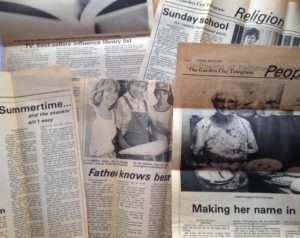 None of these stories made anyone’s Top Ten list of 1982. Probably not even grandma’s. They weren’t prizewinners or even, I see now, very well written.
None of these stories made anyone’s Top Ten list of 1982. Probably not even grandma’s. They weren’t prizewinners or even, I see now, very well written.
But I remember how proud I felt that summer. I was a “real” journalist writing real stories for a real newspaper.
These stories represent the very beginning of a theme that runs through almost all of my writing even today, in both fiction and nonfiction, and that is a love for this state, from the dry southwest corner where I grew up to the northeast region shaped by glaciers, and especially for the people who live here. One thing that summer taught me is every person has a story. Like Mrs. Porter here. 82 years old when I interviewed her about the pies she baked every single day for the little restaurant at Garden City’s airport.
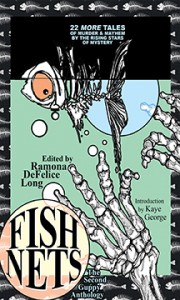 In 2011, after a lot of years of thinking about it but not doing it, I decided to try my hand at fiction. In January that year, instead of making resolutions I wouldn’t keep, I adopted “risk” as my “word of the year,” a guiding concept for stretching beyond my comfort zone. I wrote the word in all caps on a sticky note and posted it on my computer, where I could see it every day and remind myself that sometimes, a little risk can be a good thing.
In 2011, after a lot of years of thinking about it but not doing it, I decided to try my hand at fiction. In January that year, instead of making resolutions I wouldn’t keep, I adopted “risk” as my “word of the year,” a guiding concept for stretching beyond my comfort zone. I wrote the word in all caps on a sticky note and posted it on my computer, where I could see it every day and remind myself that sometimes, a little risk can be a good thing.
A couple of months later, the Guppy chapter of Sisters in Crime, an international organization that promotes women crime fiction writers, with headquarters right here in Lawrence, Kansas, announced that submissions were open for its second anthology of short stories. Opportunity knocking! I drafted my first short story ever but as the deadline for submissions crept closer, I wavered. I fiddled with the wording and revised the story and had many second thoughts. But that sticky note on my computer nagged me. It was my year of risk, right? So I took a deep breath, hit send, and “Keeping Up Appearances” was one of 22 stories accepted for publication in Fish Nets: The Second Guppy Anthology.
This was huge for me. It was the first piece of fiction I finished. First piece of fiction I submitted for other people to read. And first piece of fiction accepted for publication.
Oh my gosh. This fiction thing was a piece of cake, right?
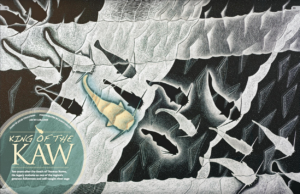 For the last 14 or 15 years, I’ve written regularly for Lawrence Magazine. Like my early Telegram days, Lawrence Mag gives me an opportunity to meet people in our community and tell their stories. The nonfiction work gives me insight into people and places in a way that sitting all day in an office does not. In one of my favorite Lawrence Mag stories, the one Debbie mentioned in her introduction, I profiled Thomas Burns, a commercial fisherman and self-taught naturalist who spent years studying the Kaw and the big catfish that inhabit it. I read his first-person accounts of his life and interviewed his family and friends, and pieced together a picture of a man who loved the river, loved fishing, and, for much of his commercial fishing career, ran afoul of Kansas laws that banned some of his techniques. Evading the law became a game for him.
For the last 14 or 15 years, I’ve written regularly for Lawrence Magazine. Like my early Telegram days, Lawrence Mag gives me an opportunity to meet people in our community and tell their stories. The nonfiction work gives me insight into people and places in a way that sitting all day in an office does not. In one of my favorite Lawrence Mag stories, the one Debbie mentioned in her introduction, I profiled Thomas Burns, a commercial fisherman and self-taught naturalist who spent years studying the Kaw and the big catfish that inhabit it. I read his first-person accounts of his life and interviewed his family and friends, and pieced together a picture of a man who loved the river, loved fishing, and, for much of his commercial fishing career, ran afoul of Kansas laws that banned some of his techniques. Evading the law became a game for him.
But later in his life, the same wildlife officials who tried to curb his illegal fishing turned to him for help when they wanted to understand more about his fishing methods and the river that has always played such a large role in our community.
This story of the complicated relationship between Burns and law enforcement fascinated me and provided a huge real-life lesson for my fiction writing: Good versus evil is a false dichotomy. The best, most interesting characters have layers—some good, some bad. Those shades of gray give a story depth.
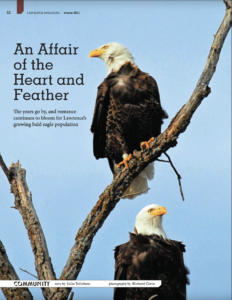 On the flip side, I credit fiction writing with helping me develop a richer approach to nonfiction. I felt this difference in an article I wrote about eagles for the Winter 2011 issue of the magazine. It began like this:
On the flip side, I credit fiction writing with helping me develop a richer approach to nonfiction. I felt this difference in an article I wrote about eagles for the Winter 2011 issue of the magazine. It began like this:
For more than two decades, an avian love story has played out in the skies over Clinton Lake.
In 1989, a pair of bald eagles set up housekeeping at the lake, joined before long by two fuzzy babies. In the words of scientists, mom and dad became the first historically documented pair of bald eagles to successfully raise young since the turn of the century in Kansas.
For the rest of us non-scientists, they’re known as the first nesting pair of bald eagles to settle in our state.
Back in my feature writing days at the Telegram, I might not have chosen to see “an avian love story” in such human terms. I wouldn’t have used the phrases “mom and dad” or “set up housekeeping,” and the story as a result would have been much less interesting.
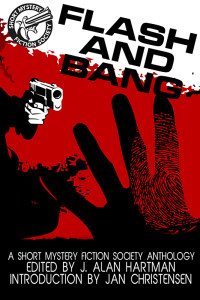 Every piece of fiction I write has some root in reality. When the Short Mystery Fiction Society announced “Flash and Bang” as the theme of its first anthology, my first thought was fireworks.
Every piece of fiction I write has some root in reality. When the Short Mystery Fiction Society announced “Flash and Bang” as the theme of its first anthology, my first thought was fireworks.
For almost three decades, my husband and I have hosted a party and crawfish boil nearly every Fourth of July. It’s one of my favorite events of the year, full of sun and fun and the friends and family I love. The irony, though, is that I don’t like fireworks, so I channeled 25 years of unease and apprehension into my entry for the anthology. The story begins with Keith, the morning after the 4th of July. Because, like me, he’s never liked the holiday, he spent most of the party in his house drinking bourbon (not like me), and his memories of the day before are a bit incoherent.
Keith clamped his jaws together. The inside of his mouth crackled as the dried sugary residue that coated his mucous membranes shattered into tiny shards like broken glass.
Good lord, how much bourbon and Coke did he drink last night? He had the massive headache that in his younger days meant he’d had a helluva good time. Today, it just meant he’d survived another of Andrea’s legendary Fourth of July parties.
A little bit later:
The stench of smoke and gunpowder assaulted him as soon as he stepped out the back door. He sidestepped the beer bottles and paper plates that littered the porch and dragged a trash can toward Andrea’s launch pad. Cleanup. His party specialty.
Through the burned-out hole in the middle of the launch pad, Keith glimpsed a jumble of cardboard boxes, plastic wraps, and depleted artillery shells. He moved the ruined plywood aside.
And discovered his wife, half covered by the remains of the fireworks she loved, a gaping bloody hole in her chest.
For the rest of the story, bits and pieces of the night before come back to him, fractured and fragmented and horrifying. I kind of feel sorry for poor Keith.
You see that love for Kansas that runs through my writing most clearly in my nonfiction, in the stories of Tom Burns and the eagles at Clinton Lake. It’s less obvious in my fiction, but it’s there, woven into the fabric of the stories. The opening paragraphs of the novel I’m working on now, tentatively called IN THE SHADOWS, grew from many days spent hiking in and exploring Kansas state parks, and then twists those experiences into something dark and dangerous. The first couple paragraphs:
Detective Jameson Brunson examined the scene as he would an Old Master painting. In a dark palette of muted browns and grays, damp tree trunks crowded the site. Early morning light, weak and tentative, filtered through branches still barren of leaves, though the swollen buds at their tips hinted at the coming spring. The air, too, smelled of spring, that peculiar mix of dew and decay that, if odors were colors, would be a shadowy “almost green.”
One tree, a sycamore, stood out from the rest. Beneath its peeling bark and white trunk, the still form of the girl lay on her back, fully clothed, legs straight, hands folded on her chest. Her long blonde hair, tipped in red, fanned out from her head like a golden halo in a renaissance portrait of the Madonna. She looked peaceful.
This is the piece that won the Holton Award from the Mystery Writers of America Midwest Chapter last year.
Debbie mentioned our trip to Australia in her intro, and I’ll tell you a little more about that story. Some of you knew my mother-in-law, Nona. If you spent any time with her, you know how fiercely she loved her children. Nona was diagnosed with stage 4 ovarian cancer in 2004. During the long days and nights that followed, she and I talked often about her children and grandchildren and her hopes and fears for their futures. One afternoon at hospice, she told me that though she had little interest in travel herself, she regretted that she’d never sent my husband to Australia, a place he’d wanted to visit since he was little. She caught me off guard, so I stammered, “Don’t worry. I’ll make sure he gets there. I promise.”
Now at the time, we had a five-year-old and two busy careers and oh yeah I’m terrified of flying. A trip to Australia seemed totally undoable. But the promise was always there in the back of my mind. Fast forward 12 years. We were getting ready to celebrate our 25th wedding anniversary, and Jake was about to graduate from high school. We told him we’d take him on a trip to celebrate and asked him where he’d like to go. The first word out of his mouth was “Australia.” He didn’t even hesitate.
So the promise had come due. It was time to face down another fear.
We packed our bags, flew 17 hours to Brisbane, and set off on a three-week adventure Down Under. And it was the best risk-reward undertaking ever. From driving a Barbie car around Magnetic Island, where we saw a koala in the wild, to dinner at the Sydney Opera House to hiking 8 miles to see aboriginal art on the sandstone cliffs in Carnarvon Gorge to feeding an orphaned baby kangaroo his nighttime bottle on a 120,000 acre cattle station in the outback, it was a fabulous trip. I’ve never been happier to keep a promise.
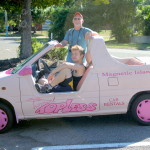
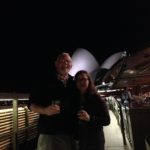
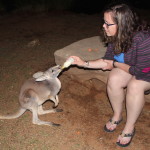
And that brings me back full circle, to the rewards of taking risks, to overcoming fear to live your best life. From submitting that first short story to getting on that plane, the most meaningful moments begin with one small step.
Again, thanks so much for inviting me tonight. I love Altrusa and the work you do for this community. And I’m so honored you asked me to be part of this.